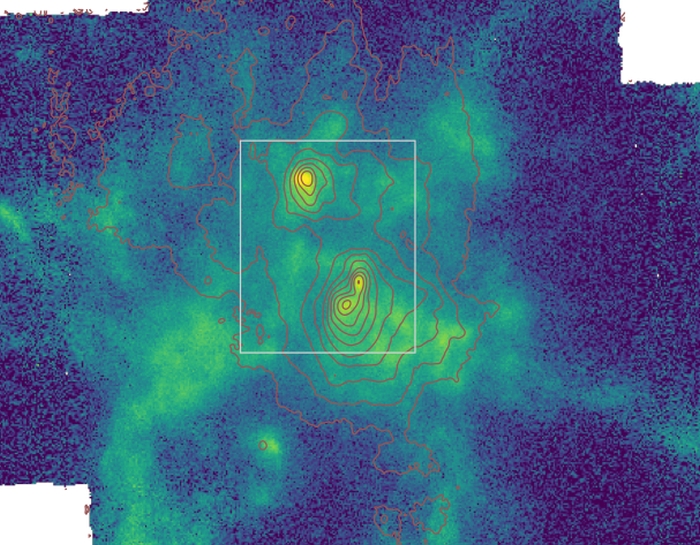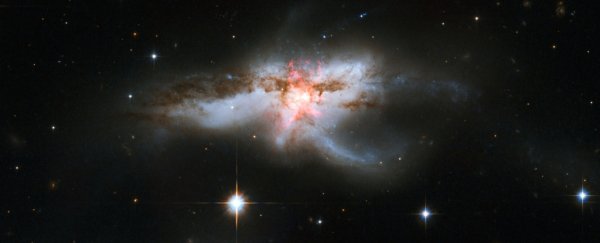Of the myriad galaxies we've seen in the night sky, NGC 6240 has always stood out for its peculiar shape and unusual infrared brightness. It was thought to be the result of two galaxies colliding - until now.
All the way back in 1983, astronomers reported evidence of a double active nucleus - two active supermassive black holes at the centre of NGC 6240. Now, for the first time, researchers have found evidence of a third supermassive black hole.
This new finding suggests that not two, but three galaxies are in the process of merging, each bringing its own supermassive black hole galactic nucleus to the party.
"Through our observations with extremely high spatial resolution," explained astrophysicist Wolfram Kollatschny from the University of Göttingen in Germany, "we were able to show that the interacting galaxy system NGC 6240 hosts not two - as previously assumed - but three supermassive black holes in its centre."
Since 1983, numerous studies of the galaxy have been conducted, confirming that finding of two active galactic nuclei at the heart of NGC 6240, which lies 300 million light-years away as the photon flies.
However, because the supermassive black holes are so close together, exactly where they are within the bright centre has remained elusive.
Kollatschny and his team used the MUSE 3D spectrograph mounted on the European Southern Observatory's eight-metre Very Large Telescope in Chile to take high-resolution spectroscopic observations of the galaxy.
These images revealed three nodes at the centre of NGC 6240 - one northern component and two southern. However, the new finding doesn't mean the previous research was wrong; the new evidence suggests that only two of the black holes are actively accreting matter, and the third is dormant.
Each of the supermassive black holes clocks in at over 90 million times the mass of the Sun (the Milky Way's supermassive black hole, Sagittarius A*, is 4 million solar masses). All three are locked in an orbit in an area less than 1 kiloparsec across (3,260 light-years), slowly spiralling inward towards each other. And the two southern black holes are separated by a distance of just 198 parsecs (645 light-years).
 (Kollatschny et al., A&A, 2019)
(Kollatschny et al., A&A, 2019)
"Such a concentration of three supermassive black holes has so far never been discovered in the Universe," said astrophysicist Peter Weilbacher of the Leibniz Institute for Astrophysics Potsdam in Germany.
"The present case provides evidence of a simultaneous merging process of three galaxies along with their central black holes."
Earlier this year another triple merger was discovered, with three supermassive black holes in the process of inspiralling at the centre of a galaxy called SDSS J084905.51+111447.2; but that system had separations between each pair of black holes of around 10 kiloparsecs.
That the black holes at the centre of NGC 6240 are closer to each other means NGC 6240 is in a later stage of its merger, a process that takes more than a billion years. This more advanced stage also means the galaxy is closer to what is known as the final parsec problem.
As we have previously reported, according to theoretical modelling the black holes of two merging galaxies are inexorably drawn together, transferring their orbital energy to the gas and stars around them, and thus orbiting in an ever-tighter spiral.
We know that pairs of stellar-mass black holes will eventually come together and form a single object. With supermassive black holes, there's a theoretical problem.
As their orbit shrinks, so too does the region of space to which they can transfer energy. By the time they're one parsec apart (around 3.2 light-years), theoretically this region of space is no longer large enough to support further orbital decay, so they remain in a stable binary orbit - potentially for billions of years. This balance is known as the 'final parsec problem'.
Triple mergers might be a solution to this problem, since the third black hole could provide the extra kick the objects need to close that final gap.
Of course, the black holes at the centre of NGC 6240 won't get anywhere close to that final parsec any time soon - it could take another billion years or two, and who even knows if humanity will be around at that point.
But the black holes are expected to be producing gravitational waves. We can't detect them yet, but by studying systems such as these, we may be able to figure out how to detect them with future instruments, and figure out what happens at that last parsec.
The research has been published in Astronomy & Astrophysics.
